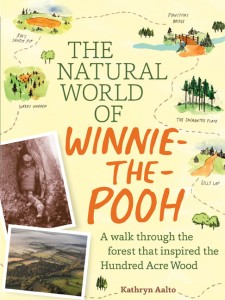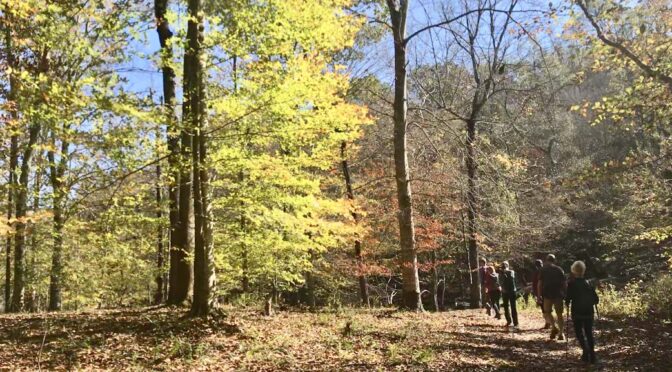The following piece first appeared in 2015, following author Kathryn Aalto’s appearance at Raleigh’s Quail Ridge Books to promote her then-new book, “The Natural World of Winnie-the-Pooh.” Aalto reflected on the joy’s of walking-at-will in her new home of England, about how little is off-limits in a country that grants a legal right to roam. Her observations and wanderings seem especially pertinent in fall, a time when all we want to do is roam and take in this season of color.
When landscape design historian/educator/author Kathryn Aalto moved her family from Seattle to England several years ago, she remembers looking down on the approaching English landscape as their plane descended and thinking,  “How am I going to raise my children here?”
“How am I going to raise my children here?”
Aalto was used to the more untamed land of the Pacific Northwest. Below her was a highly manicured rolling countryside, the result of several centuries of human domination.
“I needed to get a sense of place,” she told a gathering last night at Quail Ridge Books in Raleigh, the latest stop on her U.S. book tour. “I discovered that walking was going to do it.”
It did, resulting in part in her new book, “The Natural World of Winnie-the-Pooh.” In it, she casts a naturalist’s eye on the 6,000-acre Ashdown Forest in southeast England, the inspiration for A.A. Milne’s Hundred Acre Wood, the setting for Christopher Robin’s childhood adventures with Pooh, Piglet, Eeyore and the rest of the magical menagerie.
Aalto talked about the English countryside of bracken, gorse and heather. She talked of the “nibblers” — the goats, the sheep, the Belted Galloways — that manicure the landscape. She showed a photo of the expansive walnut tree that inspired Pooh’s home. And she shared from her research insights into Milne, his son Christopher Robin, and illustrator E.H. Shepard.

Her sizable audience was, as expected, most interested in Pooh and his world. But there was one sidebar to the main topic that drew a good deal of interest: Aalto’s walking, and the fact you can walk anywhere in England: the 267-mile Pennine Way, which runs south to north, into Scotland; the 102-mile Cotswold Way, offering insight into the English countryside; and dozens of other nationwide trails.
She spoke of the country’s “legal right to roam,” a legacy of coming into being long before the automobile, when walking was the only way to get around. If a walking path has been in existence long enough, the public has a right to walk it, private ownership be danged. A stark contrast to America, where vast distances and a desire to quickly lay claim to and conquer the land meant opting for the fastest means of transport currently available, has created a starkly different attitude toward perambulating.
“We have greenways,” one woman in the crowd commented.
“And they’re lovely,” said Aalto.
“Yes,” agreed the woman wistfully. “I just wish we had more.”
The greenway boom in the Triangle — with nearly 250 miles currently, up about 500 percent in the past two decades — can give a sense of the English walking experience. Add to that the north-south passage of the emerging 2,900-mile East Coast Greenway (one day making it possible to walk north to Canada, south to Key West, Florida), and the 1,150-mile Mountains-to-Sea Trail (walk west to Clingman’s Dome, east to Jockey’s Ridge), and an American-style walking vacation may be closer than we think.
That will go a long way toward helping more of us discover what Kathryn Aalto did when she arrived in England.
A sense of place.
